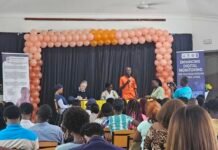By Amin Kef (Ranger)
A training exercise on Emergency First-Aid Response was conducted on the 12th April, 2023 conducted by the US Embassy in Freetown targeting journalists from both the Print and Electronic Media in Freetown.
In his declaration of the purpose of the training, the Press and Media Coordinator at the US Embassy in Freetown, Alhassan Jalloh, underscored the need to equip journalists with basic life saving skills or coping mechanisms that could be usefully administered during certain emergency situations furthering that it was thought fit to organize such against the backdrop of the country going to the polls on the 24th June, 2023.
The Medical Attache of the US Embassy in Freetown, Dr. Kathlene Horsley, who served as the Lead Facilitator pointed out that the aim of the training is not geared towards transforming journalists into medical doctors but rather to equip them with lifesaving skills as they cover events that may degenerate into chaos.
She stated that journalists will be trained on how to be first responders in case of emergencies especially on applying MARCH – Massive Hemorrhage, Airway, Respiration, Circulation, and Hypothermia.
One, among, key First Aid skills imparted was how to prevent massive and continuous hemorrhage (bleeding) of which in such a situation it was advised to ensure that an individual’s airway is clear and free from obstruction, identify respiratory distress and attend to it, ensure the promotion of blood circulation and make sure the individual who is being attended to does not lose heat and develop hypothermia.
According to the Facilitator, such is fondly known as the MARCH theory which provides a comprehensive approach to emergency first aid care by addressing the most critical aspects of an emergency situation.
Participants were told that by following the MARCH protocol, non-medical professionals who are trained can provide the necessary interventions to stabilize the patient and prevent further harm until medical care can be administered.
Dr Horsley disclosed that the first step in dealing with massive hemorrhage or severe bleeding is to apply direct pressure on the wound with a clean cloth or bandage and if the bleeding does not stop, a tourniquet should be used, which is a tight band tied around the limb above the wound to reduce blood flow.
“The tourniquet [professional or improvised] must be tied high up the limb and not just directly above the wound. Also, it must be tight,” she said further admonishing that a broad piece of material like a headscarf or a tie can be used as an improvised tourniquet.
Dr Horsley also stated the significance of ensuring that the individual’s airway is clear and free from any obstruction saying if the person is unconscious, his or her airway can be cleared by tilting their head back and lifting their chin also stressing that any visible objects that may be blocking the airway should also be removed.
According to her, in case an individual is having trouble breathing, it is advisable advised to help the person sit up straight and loose any tight clothing around his or her neck and chest maintaining that if necessary, rescue breaths can be administered by giving two quick breaths and then waiting for the chest to rise before giving two more breaths.
She informed participants that to promote blood circulation it is recommendable to place the individual on his or her back and elevate the legs, which will help blood flow to vital organs adding that if the person is not breathing, chest compression should be performed to circulate blood manually.
The Lead Facilitator stressed the importance of keeping the individual warm, particularly if he or she is in shock or have lost a lot of blood, to prevent hypothermia further suggesting covering him or her with blankets or any available clothing.
Towards the end of her presentation she did some practical demonstrations of how to apply the various life-saving techniques she had taught which was followed by question and answer session. Participants were drawn from both print and electronic media.






